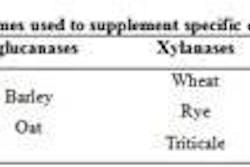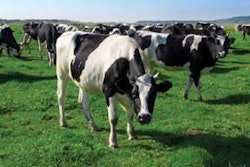Research presented at the 16th Annual Distillers Grains Symposium in St. Louis, Mo., clearly showed that industry interest is focused on oil content in DDGS and the impact of lower oil content on nutritional value. Agricultural researchers from a number of major universities presented data that indicated low oil DDGS has differing impacts, depending on the species.
Rate of oil removal
Dr. Robert Wisner, agricultural economist from Iowa State University, reported that currently near 60 percent of the ethanol plants in Iowa are removing corn oil from distillers grains products at the plant, and this number will increase to 70 percent by the end of the year. Most of the oil is going to bio-diesel production, but much of it (<50 percent) will end up in blended feed grade fats, which will eventually enter the feed industry (particularly the poultry industry). Dr. Wisner presented the following information (Table 1) about dietary ingredient replacement ratios for DDGS or DDGS in the diet of various livestock.
The current market use of distillers grains products is greatest with beef and followed by dairy, exports, swine and then poultry use. Poultry has shown the most rapid increase in market use over the past year, while cattle feed numbers have decreased. Primary export markets include Mexico, China and Canada with increased demand by Mexico and decreases in the China and Canadian markets. Overall production of distillers grains has capped at 40 million tons.
Use of low oil DDGS products
Several presentations were made that focused on the use of low oil DDGS products in beef, dairy, swine or poultry diets. Dr. Paul Walker, Illinois State University, presented research showing a decrease in oil content in Illinois derived DDGS going from an average of 10.5 to 6.7 percent. He reported the greatest efficiency of conversion in beef cattle when feeding 25 percent DDGS in the diet but the greatest economic efficiency when feeding 40-45 percent DDGS in the ration.
Low oil DDGS products were less efficient in beef rations, causing increased dry matter intake and average daily feed intake. He estimated the low oil DDGS products to have up to 25 percent less value in beef feedlot rations. Dr. Paul Kononoff, dairy extension specialist at the University of Nebraska, presented research data on the use of DDGS in dairy cows showing that dairy cows could safely be fed levels of DDGS as high as 30 percent of the ration with no negative effects on milk production. Dr. Kononoff emphasized balancing diets high in DDGS for total fiber/roughage content to prevent an imbalance of fatty acid production. Low oil DDGS in dairy cow rations was cost effective and could be more desirable than the high oil counterparts in dairy cattle.
Dr. Hans Stein, University of Illinois swine nutritionist, presented data on the efficiency of corn oil digestibility in pigs fed corn, DDGS, or corn oil. Graph 1 shows how separated corn oil is used much more efficiently than the oil still bound in whole corn, DDGS or high protein DDGS. This data is particularly noteworthy as the feed industry evaluates low oil DDGS products in monogastrics such as hogs and poultry.
DDGS in laying hen rations
Dr. Sheila E. Purdum, extension poultry specialist and professor at the University of Nebraska, presented the most recent research on the utilization of low oil DDGS products in laying hen rations. Three DDGS samples (Table 2) were tested: normal oil (11.2 percent), medium oil (7.30 percent), or low (5.62 percent) oil and compared to a diet with no DDGS.
Diets were formulated to contain 20 percent DDGS (Table 3: diets 2-4) and to be isocaloric and equal in protein to the control diets without DDGS. Medium and low oil DDGS products were formulated into the rations using the same metabolizable energy value as normal DDGS, even though researchers knew metabolizable energy was likely lower.
The diets used in this research had high metabolizable energy levels (Table 4) as indicated by gross energy analysis, calculated metabolizable energy was 2860 kcal/kg for the control and normal DDGS diets (Table 3). No adjustments were made in diet metabolizable energy for the medium or low oil DDGS diets. It was theorized that the low oil DDGS lowered overall dietary metabolizable energy intake by 6-10 kcal, thus not having an extreme effect on total energy available to the hen. Hens increased intake by about 2-2.4 grams/day on the medium and low oil diets, which was not significant (Table 5).
There were no significant effects between treatments with regards to daily egg production, feed intake, egg weight, and hen weight (Table 4) despite the reduction in dietary fat and gross energy due to the lower fat DDGS. Egg production dropped slightly with DDGS treatments, but this was not a significant decrease. Lower dietary metabolizable energy and intake did not significantly alter hen weight gain during this trial.
Need for communication
In summary, low oil DDGS products can hold a place in livestock and poultry rations, but have slightly less value as oil is taken out. Producers of low oil DDGS should not expect as high of economic value associated with low oil products compared to higher oil products in the livestock feed industry. It is very important that buyers and sellers communicate regularly about the oil content and potential impact on other nutrient levels in the DDGS product.
The availability of DDGS products for poultry and livestock will remain high as exports to countries such as China has leveled out and domestic ethanol production is steady.















